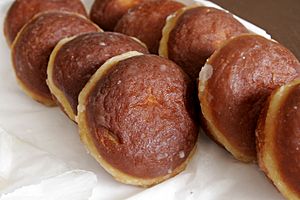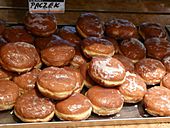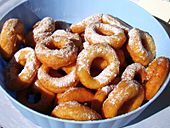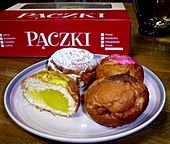Pączki facts for kids

Glazed pączki
|
|
| Alternative names | kreple |
|---|---|
| Type | Doughnut |
| Place of origin | Poland |
| Region or state | Central Europe, North America |
| Main ingredients | Yeast-based dough, grain alcohol, confiture or other sweet filling, powdered sugar, icing, glaze or bits of dried orange zest |
Pączki are delicious filled doughnuts from Poland. They are a popular sweet treat, especially during certain holidays.
Contents
What are Pączki?
Pączki are round, deep-fried pastries. They are made from dough and often filled with sweet jam or cream. After frying, pączki are usually topped with powdered sugar, icing, or a sweet glaze. Sometimes, they have bits of dried orange peel on top.
A small amount of alcohol is added to the dough before cooking. This helps the pączki not soak up too much oil while frying. Good pączki are often fluffy and have a light stripe around their middle. This stripe shows they were fried just right in fresh oil.
Pączki Fillings and Dough
Even though they look like other doughnuts, pączki are special. Their dough is very rich, made with eggs, fats, sugar, yeast, and sometimes milk. They come with many different fruit and cream fillings.
Traditional fillings include plum jam (called powidła) and wild rose petal jam. But you can find many other flavors too. These include strawberry, blueberry, raspberry, apple, and creamy fillings like Bavarian cream or custard.
History of Pączki
Pączki have been enjoyed in Poland for a very long time, at least since the Middle Ages. Back then, they were probably harder and more like a pastry with pork fat inside.
Over time, especially during the 1700s, French cooks helped improve the recipe. They made pączki lighter, softer, and more bouncy. This is how they became the delicious treats we know today.
Pączki Day Celebrations
Pączki are a big part of celebrations, especially before Lent. Lent is a time when some Christians fast or give up certain foods.
Fat Thursday in Poland
In Poland, people eat pączki especially on Fat Thursday. This is the last Thursday before Ash Wednesday, which marks the start of Lent. The main reason for making pączki was to use up rich ingredients. Things like lard, sugar, eggs, and fruit were forbidden during the fasting period of Lent.
| Sunday | Monday | Tuesday | Wednesday | (Tłusty Czwartek) |
Friday | Saturday | ||
| Sunday | Monday | (Pączki Day) |
Ash Wednesday | Thursday | Friday | Saturday | ||
|
||||||||
Pączki Day in North America
In North America, many Polish communities celebrate Pączki Day. This is especially true in cities like Chicago, Detroit, and other places with many Polish immigrants. Here, Pączki Day often happens on Fat Tuesday. This day is also known as Shrove Tuesday or Pancake Day in other cultures.
Chicago celebrates pączki on both Fat Thursday and Fat Tuesday. In cities like Buffalo, Cleveland, and Milwaukee, Pączki Day is a big event on Fat Tuesday.
Some places even have Pączki Day parades and eating contests! For example, in Hamtramck, Michigan, there is an annual Pączki Day parade. Many bakeries in these areas have long lines of people waiting to buy pączki on this special day.
Pączki in the United States
Pączki have become very popular in the United States. This is thanks to Polish immigrants who brought their traditions with them. Bakeries often sell them mainly on Fat Tuesday and Fat Thursday.
You can find pączki in areas with many Polish immigrants. These include parts of Wisconsin, Illinois, Indiana, Michigan, Ohio, Pennsylvania, New Jersey, and Connecticut. The Polish community in Buffalo, New York, hosts one of the biggest Fat Thursday events outside of Poland.
See also
 In Spanish: Pączek para niños
In Spanish: Pączek para niños





